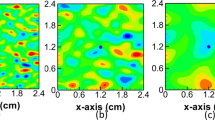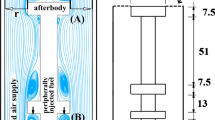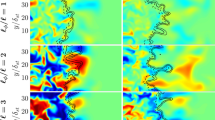Abstract
The influences of fuel Lewis number L e F on localised forced ignition of globally stoichiometric stratified mixtures have been analysed using three-dimensional compressible Direct Numerical Simulations (DNS) for cases with L e F ranging from 0.8 to 1.2. The globally stoichiometric stratified mixtures with different values of root-mean-square (rms) equivalence ratio fluctuation (i.e. ϕ ′= 0.2, 0.4 and 0.6) and the Taylor micro-scale l ϕ of equivalence ratio ϕ variation (i.e. l ϕ /l f = 2.1, 5.5 and 8.3 with l f being the Zel’dovich flame thickness of the stoichiometric laminar premixed flame) have been considered for different initial rms values of turbulent velocity u ′. A pseudo-spectral method is used to initialise the equivalence ratio variation following a presumed bi-modal distribution for prescribed values of ϕ ′ and l ϕ /l f for global mean equivalence ratio 〈ϕ〉=1.0. The localised ignition is accounted for by a source term in the energy transport equation that deposits energy for a stipulated time interval. It has been observed that the maximum values of temperature and the fuel reaction rate magnitude increase with decreasing L e F during the period of external energy deposition. The initial values of L e F , u ′/S b(ϕ=1), ϕ ′ and l ϕ /l f have been found to have significant effects on the extent of burning of the stratified mixtures following localised ignition. For a given value of u ′/S b(ϕ=1), the extent of burning decreases with increasing L e F . An increase in u ′ leads to a monotonic reduction in the burned gas mass for all values of L e F in all stratified mixture cases but an opposite trend is observed for the L e F =0.8 homogeneous mixture. It has been found that an increase in ϕ ′ has adverse effects on the burned gas mass, whereas the effects of l ϕ /l f on the extent of burning are non-monotonic and dependent on ϕ ′ and L e F . Detailed physical explanations have been provided for the observed L e F , u ′/S b(ϕ=1), ϕ ′ and l ϕ /l f dependences.
Article PDF
Similar content being viewed by others
Avoid common mistakes on your manuscript.
References
Lefebvre, A.H.: Gas Turbine Combustion, 2nd edn., pp. 50–57. Taylor & Francis (1998)
Ballal, D.R., Lefebvre, A.: The influence of flow parameters on minimum ignition energy and quenching distance. Proc. Combust. Inst. 15, 1473–1481 (1975)
Ballal, D.R., Lefebvre, A.: Ignition and flame quenching of flowing heterogeneous fuel-air mixtures. Combust. Flame 35, 155–168 (1979)
Ballal, D.R., Lefebvre, A.: A general model of spark ignition for gaseous and liquid fuel air mixtures. Proc. Combust. Inst. 18, 737–1746 (1980)
Huang, C.C., Shy, S.S., Liu, C.C., Yan, Y.Y.: A transition on minimum ignition energy for lean turbulent methane combustion in flamelets and distributed regimes. Proc. Combust. Inst. 31, 1401–1409 (2007)
Poinsot, T., Candel, S., Trouvé, A.: Applications of direct numerical simulation to premixed turbulent combustion. Prog. Energy Combust. Sci. 21, 531–576 (1995)
Klein, M., Chakraborty, N., Cant, R.S.: Effects of turbulence on self-sustained combustion in premixed flame Kernels: A Direct Numerical Simulation (DNS) study, Flow Turb. Combust., (accepted) (2008)
Chakraborty, N., Mastorakos, E., Cant, R.S.: Effects of turbulence on spark ignition in inhomogeneous mixtures: A Direct Numerical Simulation (DNS) study. Combust. Sci. Technol. 179(1-2), 293–317 (2007)
Chakraborty, N., Mastorakos, E.: Direct Numerical Simulations of localised forced ignition in turbulent mixing layers: the effects of mixture fraction and its gradient. Flow Turb. Combust. 80, 155–186 (2008)
Chakraborty, N., Hesse, H., Mastorakos, E.: Effects on fuel Lewis number on localised forced ignition of turbulent mixing layers. Flow. Turb. Combust. 84, 125–166 (2010)
Wandel, A.P., Chakraborty, N., Mastorakos, E.: Direct Numerical Simulations of turbulent flame expansion in fine sprays. Proc. Combust. Inst. 32, 2283–2290 (2009)
Wandel, A.: Extinction indicators in turbulent sprays. Proc. Combust. Inst. 34, 1625–1632 (2013)
Wandel, A.: Influence on scalar dissipation on flame success in turbulent sprays with spark ignition. Combust. Flame 161, 2679–2600 (2014)
Ahmed, S.F., Mastorakos, E.: Spark Ignition of lifted turbulent jet flames. Combust. Flame 146, 215–231 (2006)
Ahmed, S.F., Balachandran, R., Mastorakos, E.: Measurements of ignition probability in turbulent non-premixed counterflow flames. Proc. Combust. Inst. 31, 1507–1513 (2007)
Swaminathan, N., Grout, R., Mastorakos, E.: Direct simulation of forced ignition in stratified turbulent mixture. In: Proceedings 3 rd European Combustion Meeting. Chania, Greece (2007)
Pera, C., Chevillard, S., Reveillon, J.: Effect of residual burnt gas heterogeneity on early flame propagation and on cyclic variability in spark-ignited engines. Combust. Flame 160, 1020–1032 (2013)
Patel, D., Chakraborty, N.: Localised forced ignition of globally stoichiometric stratified mixtures: A numerical investigation. Combust. Theor. Model. 18(7), 627–651 (2014)
Strehlow, R.A.: Fundamentals of Combustion. International Textbook, Scranton (1968)
Glassman, I.: Combustion, 2nd edn. Academic Press, New York (1987)
Sibulkin, M., Siskind, K.S.: Numerical study of initiation of a combustion wave by an ignition kernel. Combust. Flame 69, 49–57 (1987)
He, L.: Critical conditions for spherical flame initiation in mixtures with high Lewis numbers. Combust. Theor. Model. 4, 159–172 (2000)
Eswaran, V., Pope, S.B.: Direct Numerical Simulations of the turbulent mixing of a passive scalar. Phys. Fluids 31, 506–520 (1988)
Hélie, J., Trouvé, A.: Turbulent flame propagation in partially premixed combustion. Proc. Combust. Inst. 27, 891–898 (1998)
Grout, R., Swaminathan, N., Cant, R.S.: Effects of compositional fluctuations on premixed flames. Combust. Theor. Model. 13, 823–852 (2009)
Malkeson, S.P., Chakraborty, N.: A-priori Direct Numerical Simulation analysis of algebraic models of variances and scalar dissipation rates for Reynolds Averaged Navier Stokes Simulations for low Damköhler number turbulent partially-premixed combustion. Combust. Sci. Technol. 182, 960–999 (2010)
Chen, J.H., Choudhary, A., Supinski, B. de, DeVries, M., Hawkes, E.R., Klasky, S., Liao, W.K., Ma, K.L., Mellor-Crummey, J., Podhorski, N., Sankaran, R., Shende, S., Yoo, C.S.: Direct Numerical Simulations of turbulent combustion using S3D, vol. 2, p 015001 (2009)
Tarrazo, E., Sanchez, A., Liñán, A., Williams, F.A.: A simple one-step chemistry model for partially premixed hydrocarbon combustion. Combust. Flame 147, 32–38 (2006)
Poinsot, T., Echekki, T., Mungal, M.: A study of the laminar flame tip and implications for turbulent premixed combustion. Combust. Sci. Technol. 81(1–3), 45–73 (1992)
Louch, D.S., Bray, K.N.C.: Vorticity in unsteady premixed flames: Vortex pair-Premixed flame interactions under imposed body forces and various degrees of heat release and laminar flame thickness. Combust. Flame 125, 1279–1309 (2001)
Treurniet, T.C., Nieuwstadt, F.T.M., Boersma, B.J.: Direct numerical simulation of homogeneous turbulence in combination with premixed combustion at low Mach number modeled by the G-equation. J. Fluid Mech. 565, 25–62 (2006)
Schroll, P., Mastorakos, E., Cant, R.S.: Direct Numerical Simulations of autoignition in turbulent two phase flows. Proc. Combust. Inst. 32, 2275–2282 (2009)
Bilger, R.W.: The structure of turbulent nonpremixed flames. Proc. Combust. Inst. 23, 475–488 (1988)
Espí, C.V., Liñán, A.: Fast, non-diffusive ignition of a gaseous reacting mixture subject to a point energy source. Combust. Theor. Modell. 5, 485–498 (2001)
Espí, C.V., Liñán, A.: Thermal-diffusive ignition and flame initiation by a local energy source. Combust. Theor. Modell. 6, 297–315 (2002)
Neophytou, A., Mastorakos, E., Cant, R.S.: DNS of spark ignition and edge flame propagation in turbulent droplet-laden mixing layers. Combust. Flame 157, 1071–1086 (2010)
Ballal, D.R., Lefebvre, A.H.: Ignition and flame quenching in flowing gaseous mixtures. Proc. Roy. Soc. Lond. A. 1977, 163–181
Patel, D., Chakraborty, N.: Effects of energy deposition characteristics on localised forced ignition of homogeneous mixtures. Int. J. Spray and Combust. Dyn. 7, 151–174 (2015)
Jenkins, K.W., Cant, R.S. DNS of Turbulent Flame Kernels. In: Liu, C., Sakell, L., Beautner, T. (eds.) : Proceeding 2 nd AFOSR Conference on DNS and LES, pp. 192–202. Kluwer, Norwell (1999)
Poinsot, T., Lele, S.K.: Boundary conditions for direct simulation of compressible viscous flows. J. Comp. Phys. 101, 104–129 (1992)
Rogallo, R.S.: Numerical experiments in homogeneous turbulence, NASA TM81315. NASA Ames Research Center, California (1981)
Haworth, D., Blint, R., Cuenot, B., Poinsot, T.: Numerical simulation of turbulent propane-air combustion with non homogeneous reactants. Combust. Flame 121, 395–417 (2000)
Jiménez, C., Cuenot, B., Poinsot, T., Haworth, D.: Direct numerical simulation and modelling for lean stratified propane-air flames. Combust. Flame 128, 1–21 (2002)
Yu, R., Bai, X-S.: Direct Numerical Simulation of lean hydrogen/air auto-ignition in a constant volume enclosure. Combust. Flame 160, 1706–1716 (2010)
Malkeson, S.P., Chakraborty, N.: Statistical analysis of displacement speed in turbulent stratified flames: A Direct Numerical Simulation study. Combust. Sci. Technol. 182, 1841–1883 (2010)
Yamashita, H., Shimada, M., Takeno, T.: A numerical study on flame stability at a the transition point of jet diffusion flames. Proc. Combust. Inst. 26, 27–34 (1996)
Vedula, P., Yeung, P.K., Fox, R.O.: Dynamics of scalar dissipation in isotropic turbulence: A numerical and modelling study. J. Fluid Mech. 433, 29–60 (2001)
Birch, A.D., Brown, D.R., Dodson, M.G.: Ignition probabilities in turbulent mixing flows. Proc. Combust. Inst. 18, 1775–1780 (1981)
Rashkovoksky, S.A.: Spark ignition in imperfectly mixed reactants. In: Proceedings of 1 st Mediterranean Combustion Symposium, pp. 1403–1411, Anatalya, Turkey (1999)
Alvani, R.E., Fairweather, M.: Ignition characteristics of turbulent jet flows. Trans. Ichem. E. 80, 917–923 (2002)
Renou, B., Samson, E., Boukhalfa, A.M.: An experimental study of freely-propagating turbulent propane-air flames in stratified inhomogeneous mixtures. Combust. Sci. Technol. 176 (1867)
Author information
Authors and Affiliations
Corresponding author
Rights and permissions
Open Access This article is distributed under the terms of the Creative Commons Attribution 4.0 International License (http://creativecommons.org/licenses/by/4.0/), which permits unrestricted use, distribution, and reproduction in any medium, provided you give appropriate credit to the original author(s) and the source, provide a link to the Creative Commons license, and indicate if changes were made.
About this article
Cite this article
Patel, D., Chakraborty, N. Effects of Fuel Lewis Number on Localised Forced Ignition of Globally Stoichiometric Stratified Mixtures: a Numerical Investigation. Flow Turbulence Combust 96, 1083–1105 (2016). https://doi.org/10.1007/s10494-015-9692-3
Received:
Accepted:
Published:
Issue Date:
DOI: https://doi.org/10.1007/s10494-015-9692-3




